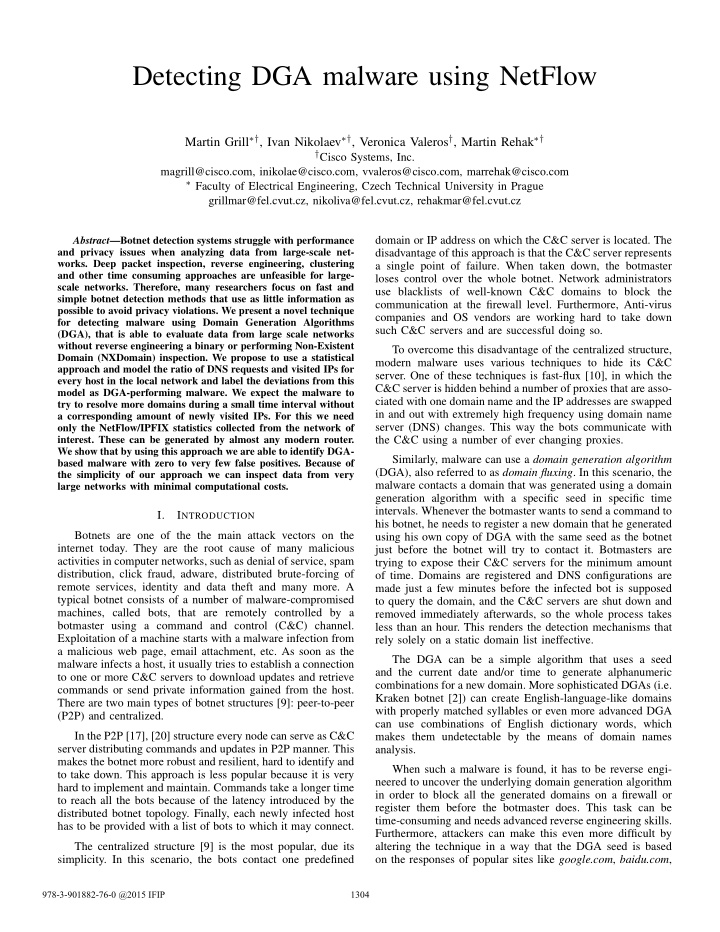



Detecting DGA malware using NetFlow Martin Grill ∗† , Ivan Nikolaev ∗† , Veronica Valeros † , Martin Rehak ∗† † Cisco Systems, Inc. magrill@cisco.com, inikolae@cisco.com, vvaleros@cisco.com, marrehak@cisco.com ∗ Faculty of Electrical Engineering, Czech Technical University in Prague grillmar@fel.cvut.cz, nikoliva@fel.cvut.cz, rehakmar@fel.cvut.cz Abstract —Botnet detection systems struggle with performance domain or IP address on which the C&C server is located. The and privacy issues when analyzing data from large-scale net- disadvantage of this approach is that the C&C server represents works. Deep packet inspection, reverse engineering, clustering a single point of failure. When taken down, the botmaster and other time consuming approaches are unfeasible for large- loses control over the whole botnet. Network administrators scale networks. Therefore, many researchers focus on fast and use blacklists of well-known C&C domains to block the simple botnet detection methods that use as little information as communication at the firewall level. Furthermore, Anti-virus possible to avoid privacy violations. We present a novel technique companies and OS vendors are working hard to take down for detecting malware using Domain Generation Algorithms such C&C servers and are successful doing so. (DGA), that is able to evaluate data from large scale networks without reverse engineering a binary or performing Non-Existent To overcome this disadvantage of the centralized structure, Domain (NXDomain) inspection. We propose to use a statistical modern malware uses various techniques to hide its C&C approach and model the ratio of DNS requests and visited IPs for server. One of these techniques is fast-flux [10], in which the every host in the local network and label the deviations from this C&C server is hidden behind a number of proxies that are asso- model as DGA-performing malware. We expect the malware to ciated with one domain name and the IP addresses are swapped try to resolve more domains during a small time interval without in and out with extremely high frequency using domain name a corresponding amount of newly visited IPs. For this we need server (DNS) changes. This way the bots communicate with only the NetFlow/IPFIX statistics collected from the network of interest. These can be generated by almost any modern router. the C&C using a number of ever changing proxies. We show that by using this approach we are able to identify DGA- Similarly, malware can use a domain generation algorithm based malware with zero to very few false positives. Because of (DGA), also referred to as domain fluxing . In this scenario, the the simplicity of our approach we can inspect data from very malware contacts a domain that was generated using a domain large networks with minimal computational costs. generation algorithm with a specific seed in specific time intervals. Whenever the botmaster wants to send a command to I. I NTRODUCTION his botnet, he needs to register a new domain that he generated Botnets are one of the the main attack vectors on the using his own copy of DGA with the same seed as the botnet internet today. They are the root cause of many malicious just before the botnet will try to contact it. Botmasters are activities in computer networks, such as denial of service, spam trying to expose their C&C servers for the minimum amount distribution, click fraud, adware, distributed brute-forcing of of time. Domains are registered and DNS configurations are remote services, identity and data theft and many more. A made just a few minutes before the infected bot is supposed typical botnet consists of a number of malware-compromised to query the domain, and the C&C servers are shut down and machines, called bots, that are remotely controlled by a removed immediately afterwards, so the whole process takes botmaster using a command and control (C&C) channel. less than an hour. This renders the detection mechanisms that Exploitation of a machine starts with a malware infection from rely solely on a static domain list ineffective. a malicious web page, email attachment, etc. As soon as the The DGA can be a simple algorithm that uses a seed malware infects a host, it usually tries to establish a connection and the current date and/or time to generate alphanumeric to one or more C&C servers to download updates and retrieve combinations for a new domain. More sophisticated DGAs (i.e. commands or send private information gained from the host. Kraken botnet [2]) can create English-language-like domains There are two main types of botnet structures [9]: peer-to-peer with properly matched syllables or even more advanced DGA (P2P) and centralized. can use combinations of English dictionary words, which In the P2P [17], [20] structure every node can serve as C&C makes them undetectable by the means of domain names server distributing commands and updates in P2P manner. This analysis. makes the botnet more robust and resilient, hard to identify and When such a malware is found, it has to be reverse engi- to take down. This approach is less popular because it is very neered to uncover the underlying domain generation algorithm hard to implement and maintain. Commands take a longer time in order to block all the generated domains on a firewall or to reach all the bots because of the latency introduced by the register them before the botmaster does. This task can be distributed botnet topology. Finally, each newly infected host time-consuming and needs advanced reverse engineering skills. has to be provided with a list of bots to which it may connect. Furthermore, attackers can make this even more difficult by The centralized structure [9] is the most popular, due its altering the technique in a way that the DGA seed is based simplicity. In this scenario, the bots contact one predefined on the responses of popular sites like google.com , baidu.com , 978-3-901882-76-0 @2015 IFIP 1304
Recommend
More recommend